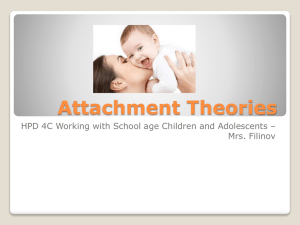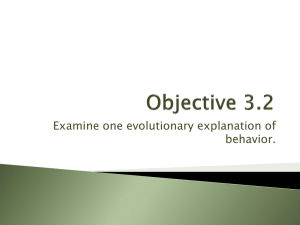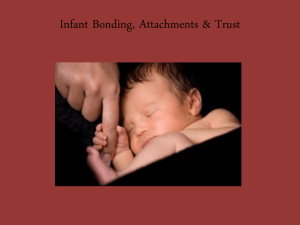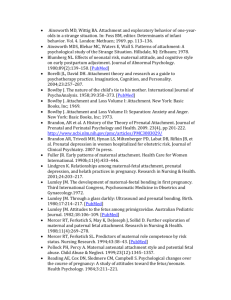Attachment Theory
advertisement
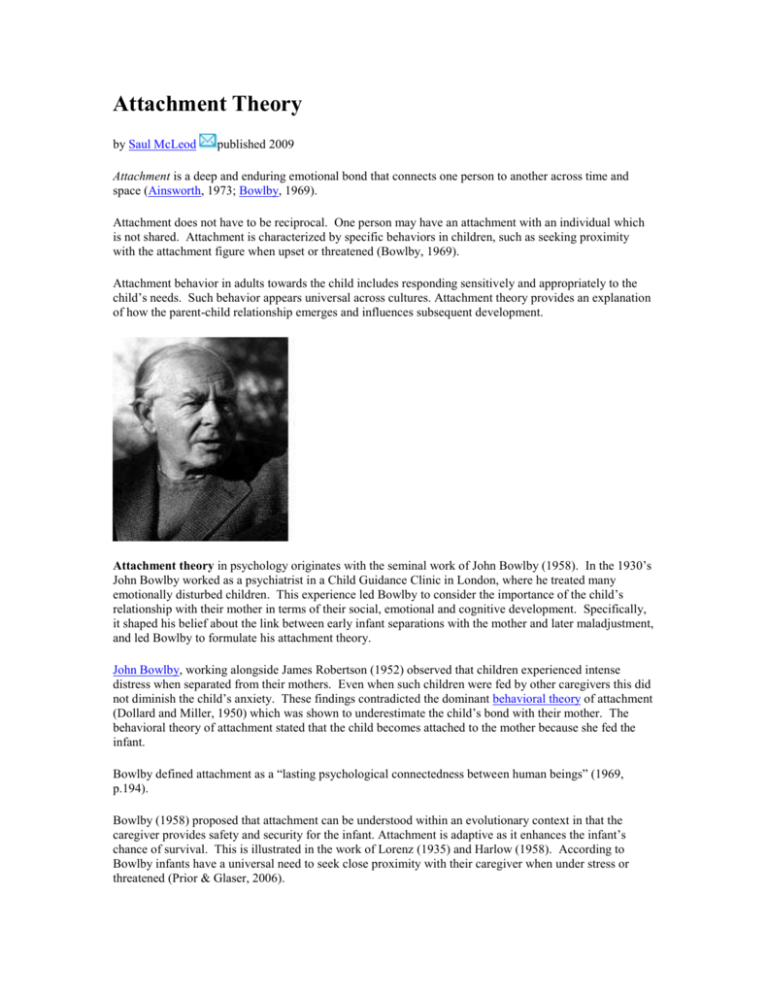
Attachment Theory by Saul McLeod published 2009 Attachment is a deep and enduring emotional bond that connects one person to another across time and space (Ainsworth, 1973; Bowlby, 1969). Attachment does not have to be reciprocal. One person may have an attachment with an individual which is not shared. Attachment is characterized by specific behaviors in children, such as seeking proximity with the attachment figure when upset or threatened (Bowlby, 1969). Attachment behavior in adults towards the child includes responding sensitively and appropriately to the child’s needs. Such behavior appears universal across cultures. Attachment theory provides an explanation of how the parent-child relationship emerges and influences subsequent development. Attachment theory in psychology originates with the seminal work of John Bowlby (1958). In the 1930’s John Bowlby worked as a psychiatrist in a Child Guidance Clinic in London, where he treated many emotionally disturbed children. This experience led Bowlby to consider the importance of the child’s relationship with their mother in terms of their social, emotional and cognitive development. Specifically, it shaped his belief about the link between early infant separations with the mother and later maladjustment, and led Bowlby to formulate his attachment theory. John Bowlby, working alongside James Robertson (1952) observed that children experienced intense distress when separated from their mothers. Even when such children were fed by other caregivers this did not diminish the child’s anxiety. These findings contradicted the dominant behavioral theory of attachment (Dollard and Miller, 1950) which was shown to underestimate the child’s bond with their mother. The behavioral theory of attachment stated that the child becomes attached to the mother because she fed the infant. Bowlby defined attachment as a “lasting psychological connectedness between human beings” (1969, p.194). Bowlby (1958) proposed that attachment can be understood within an evolutionary context in that the caregiver provides safety and security for the infant. Attachment is adaptive as it enhances the infant’s chance of survival. This is illustrated in the work of Lorenz (1935) and Harlow (1958). According to Bowlby infants have a universal need to seek close proximity with their caregiver when under stress or threatened (Prior & Glaser, 2006). Most researchers believe that attachment develops through a series of stages. Stages of Attachment Rudolph Schaffer and Peggy Emerson (1964) studied 60 babies at monthly intervals for the first 18 months of life (This is known as a longitudinal study). The children were all studied in their own home and a regular pattern was identified in the development of attachment. The babies were visited monthly for approximately one year, their interactions with their carers were observed, and carers were interviewed. Evidence for the development of an attachment was that the baby showed separation anxiety after a carer left. They discovered that baby's attachments develop in the following sequence: o o o o Up to 3 months of age - Indiscriminate attachments. The newborn is predisposed to attach to any human. Most babies respond equally to any caregiver. After 4 months - Preference for certain people. Infants they learn to distinguish primary and secondary caregivers but accept care from anyone; After 7 months - Special preference for a single attachment figure. The baby looks to particular people for security, comfort and protection. It shows fear of strangers (stranger fear) and unhappiness when separated from a special person (separation anxiety). Some babies show stranger fear and separation anxiety much more frequently and intensely than others, but nevertheless they are seen as evidence that the baby has formed an attachment. This has usually developed by one year of age. After 9 months - Multiple attachments. The baby becomes increasingly independent and forms several attachments. The results of the study indicated that attachments were most likely to form with those who responded accurately to the baby's signals, not the person they spent most time with. Schaffer and Emerson called this sensitive responsiveness. Many of the babies had several attachments by 10 months old, including attachments to mothers, fathers, grandparents, siblings and neighbors. The mother was the main attachment figure for about half of the children at 18 months old and the father for most of the others. The most important fact in forming attachments is not who feeds and changes the child but who plays and communicates with him or her. Attachment Theory Psychologists have proposed two main theories that are believed to be important in forming attachments. Learning / behaviorist theory of attachment (e.g. Dollard & Miller, 1950) suggests that attachment is a set of learned behaviors. The basis for the learning of attachments is the provision of food. An infant will initially form an attachment to whoever feeds it. They learn to associate the feeder (usually the mother) with the comfort of being fed and through the process of classical conditioning, come to find contact with the mother comforting. They also find that certain behaviors (e.g. crying, smiling) bring desirable responses from others (e.g. attention, comfort), and through the process of operant conditioning learn to repeat these behaviors in order to get the things they want. Evolutionary theory of attachment (e.g. Bowlby, Harlow, Lorenz) suggests that children come into the world biologically pre-programmed to form attachments with others, because this will help them to survive. The infant produces innate ‘social releaser’ behaviors such as crying and smiling that stimulate innate caregiving responses from adults. The determinant of attachment is not food but care and responsiveness. Bowlby suggested that a child would initially form only one primary attachment (monotropy) and that the attachment figure acted as a secure base for exploring the world. The attachment relationship acts as a prototype for all future social relationships so disrupting it can have severe consequences. This theory also suggests that there is a critical period for developing at attachment (about 0 -5 years). If an attachment has not developed during this period then the child will suffer from irreversible developmental consequences, such as reduced intelligence and increased aggression. Harlow’s Monkeys (1958) The behaviorist framework of explanation would suggest that an infant would form an attachment with a carer that provides food (in behaviorist terms, food is the primary reinforcer, the provider of the food is the secondary reinforcer). Harlow and Zimmerman (1958) found evidence against this hypothesis using rhesus monkeys. Harry Harlow did a number of studies on attachment in monkeys during the 1950's. He stated that monkeys must form their attachments during the first year of life (re: critical period). His experiments took several forms: 1. Infant monkeys reared in isolation – some died, others were frightened and behaved in an abnormal manner. They could not interact with other monkeys even when they were older. 2. Infant monkeys reared with surrogate mothers – either bare wire mothers or wire mothers covered in soft terry toweling cloth. A feeding bottle was attached to the bare wire mother. The monkeys spent more time with the cloth mother. The infant would only go to the wire mother when hungry. Once fed it would return to the cloth mother for most of the day. If a frightening object was placed in the cage the infant took refuge with the cloth mother (its safe base). This surrogate was more effective in decreasing the youngsters fear. The infant would explore more when the cloth mother was present. This supports the evolutionary theory of attachment, in that it is the sensitive response and security of the caregiver that is important (as apposed to the provision of food). Harlow concluded that for a monkey to develop normally s/he must have some interaction with an object to which they can cling during the first months of life (critical period). Clinging is a natural response - in times of stress the monkey runs to the object to which it normally clings as if the clinging decreases the stress. Harlow found therefore that it was social deprivation rather than maternal deprivation that the young monkeys were suffering from. When he brought some other infant monkeys up on their own but with 20 minutes a day in a playroom with three other monkeys he found they grew up to be quite normal emotionally and socially. Harlow’s work has been criticized. His experiments have been seen as unnecessarily cruel (unethical) and of limited value in attempting to understand the effects of deprivation on human infants. However one psychologist who was strongly influenced by Harlow's research was John Bowlby.

